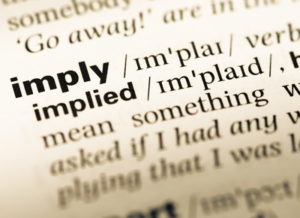If you have played poker for any period of time and also read up about the game to try and improve your knowledge, implied odds in poker is something you will have seen before. But what does this actually mean, how can you calculate the implied odds and how can you use this to make yourself a better poker player in the long term?
What are Implied Odds?
 Understanding the odds is critical in any form of gambling, and increasingly so in poker, we are seeing players use this to shape how they play. Rather than just getting a feel for the game and your chances, working out the odds mathematically is something that many players are now doing.
Understanding the odds is critical in any form of gambling, and increasingly so in poker, we are seeing players use this to shape how they play. Rather than just getting a feel for the game and your chances, working out the odds mathematically is something that many players are now doing.
If you play poker on a regular basis then you want to be doing everything you can to try and secure long term profit for yourself. This is achieved by stacking the odds in your favour, and by playing when those odds show that you have a chance of winning.
Get this right and play your hand and take risks when the odds are in your favour, and you are likely to perform well over time. However, chase at a time when the odds are not in your favour and you could find yourself losing money on a regular basis.
The key odds here are implied odds.
Implied odds is an estimation of the money you will win from a poker hand if you hit one of your potential outs. They tell you how much extra money you need to make on the next street when you are getting incorrect pot odds, which we will come onto shortly.
Using implied odds will tell you if you should continue, because the money you win from the pot makes it worthwhile gambling on the next card turning your hand into a strong winning hand. This is something you will use when you are facing bet and raises during a game, at this stage you have a decision to make as to whether you continue or not.
At this point in a game, some people will calculate the implied odds and play solely using those, while others will use a combination of pot odds and implied odds to work out whether they are getting value by continuing.
Of course, before you do any of that it is worth knowing the raw odds behind any given hand in poker at the pre-flop, flop and board stages. You can read about common Poker Odds here.
What are Pot Odds?
 The other odds to consider are pot odds, these offer a simpler approach to the game than implied odds. The pot odds are based around your bet amount, the amount of money in the pot and the odds that gives you, compared to your chances of success.
The other odds to consider are pot odds, these offer a simpler approach to the game than implied odds. The pot odds are based around your bet amount, the amount of money in the pot and the odds that gives you, compared to your chances of success.
The key here is that this looks at the long term, and the odds based on if you were to keep placing that bet time and time again. If you bet 10 into the pot, and the pot on offer is 200, then the pot odds are effectively 19:1. This means that you can get this bet wrong 19 times, and get it right once, and you won’t lose money, you will break even.
When you know the pot odds, you then have to understand the odds of you winning based on the hand you have. If this is a hand that you believe will give you a win five times in a spell of 20 games, then considering the pot odds only need you to be right once in 20 games to break even, this is certainly a scenario where you should play on. In the long run, everything is pointing towards this being a profitable bet to place.
What is the Difference Between Implied Odds and Pot Odds?

Implied odds are more complex than pot odds and are based on how your hands could turn out in the future, and where you can try and seek value if something goes your way. Pot odds are a slightly simpler version of things, they are based on the amount of money in the pot, the amount of money you can win and how that compares to the odds you believe your hand has.
If you are relatively new to poker, the way that this game is heading, you really need both of these on side and you need to know how to use them.
Calculating Implied Odds
 If you are looking to calculate the implied odds on your game then there is a specific formula which you can use to work this out.
If you are looking to calculate the implied odds on your game then there is a specific formula which you can use to work this out.
The formula for calculation is this:
= [ (1/EQ) * C] – (P + C)
There are three variables inside this equation that you need to know.
EQ = the equity of your hand vs their betting range
P = the size of pot after your opponent’s bets and raises
C = how much you have to call right
An Example of Implied Odds Being Applied
 This is an example of using implied odds because you are getting the wrong pot odds for the bet to be a successful one.
This is an example of using implied odds because you are getting the wrong pot odds for the bet to be a successful one.
In the example, we will use the position of facing a turn bet, and here are the implied odds for that.
- Opponent bets 30 into a pot that is 100
- Your hand equity at this stage is 8%
- The pot odds in this instance are 4.3:1, which means you are getting incorrect pot odds
- With this in mind, you consider using implied odds to decide whether you make the bet or not
The next step is to use the figures above to work out the implied odds
= [ (1/EQ) * C] – (P + C)
= [( 1 / .08 ) * 30] – ( 130 + 30 )
As you can see here, the .08 is your hand equity, 30 is the bet, 130 is the new pot and then your bet afterwards would be the 30 again.
The calculation then becomes:
= (12.5 * 30) – (160)
= 375 – 160
= 215
Now you have your implied odds figure, which is 215.
This is the figure that you need to make, or more than this, anything below that, and the best option for your bet is to fold, because the implied odds don’t give you enough reward for the risk you are taking on the bet.
Considerations with Implied Odds

This is, of course, not an exact science here, we are talking about a hugely complex aspect of poker gaming and for that reason there are a handful of things to consider when you are playing. These will have an impact both on how you play and how your opponent plays, so make sure you include them in your calculations.
How Likely is an Opponent Bluff?
If you know your opponents well, you should have a feel for how often they are going to bluff, either often, sometimes or not at all. This really plays a part with implied odds, so is certainly something to try and work out.
Even when you are out of position, which we will come to next, if you are against an opponent that bluffs then this will help you with draws based on implied odds. What you want to do here is hit your draw and check, allowing the bluffing player to bet again, which increases the pot and that increases the implied odds for you to take advantage of.
Flop Implied Odds
If you multiple your outs by 4 then there is a chance that you will improve your hand on either the flop or the turn. If you are relating this to the implied odds, you may not be guaranteed to get both cards for the same price.
After calling the flop, watch for your opponent to continue betting on the turn, which means you are paying even more for the draw. If you are looking at the chances of improving on the next card, multiply by 2, if you are looking at the turn or the river, multiple by 4.
What Happens When You Are Out of Position?
This is a position that you will find yourself in from time to time, and it is important that you know what to do when in it. If facing a turn bet, with the wrong pot odds, but right implied odds, this is known as being out of position. This is going to make it harder to get value from your opponent in this situation, but it is still possible.
Checking is the best option, especially if you mix up your hands while checking, so you have a history of calls and bluffs while checking, and the opponent doesn’t know what is coming up next. The key with being out of position is that it is harder to make your opponent pay you off. If you check, you risk them checking back, or alternatively if you bet, they could fold, which means no bet at all.
Alternative Strategy – Raising with Draws
There are more variances and alternative strategies that you can use while playing poker. Sometimes, the ideal position to be in is to raise with your draw, rather that relying on either implied odds or pot odds to help you achieve a profit.
Raising on the flop or turn can sometimes be a play that puts you in a position to make a profit. For example, if you are facing an opponent that bets too frequently and folds when they are faced with someone betting back at them, this is a good time to raise with draws.
The same can be said if you are playing an opponent that overfolds, and one of the biggest signs of this can be when they fold frequently when you raise after a check. Perhaps the best time to raise with draws is when you are out of position. The reason being is that is can be a struggle to get the extra bet with implied odds when you are out of position, so this is a good alternative to that.
If you raise with draws, you gain fold equity at this point. There is an option to win the pot straight away, if your opponent folds after your bet, or the option to win a bigger pot when you do make your draw further down the line.
